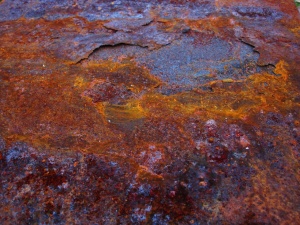Chlorides
Environments where the protective rust layer cannot spontaneously form on weathering steels is in coastal environments where the amount of air-borne sea-salt particles is relatively high. A general metric Distressed Metals uses when identifying zones where weathering steel will have protective issues with salt deposition into the oxide layer is areas located within 1 mile from the ocean shore that receive continual salt spray. When salt is continually deposited onto the steel surface, it tends to develop the rust product Akaganéite which is a non-adherent rust product and in high concentrations is not constructive to the development of the inner
into the oxide layer is areas located within 1 mile from the ocean shore that receive continual salt spray. When salt is continually deposited onto the steel surface, it tends to develop the rust product Akaganéite which is a non-adherent rust product and in high concentrations is not constructive to the development of the inner
protective oxide layer. Beware of weathering steel products which use high amounts of chloride (salt) as a initiator to the rust layer. Over time they will display the non-adherent nature of their oxide layer and do not provide adequate corrosion protection that is typically desired when using weathering steel as a cladding material.
De-icing Salt
The use of de-icing salts on roads in close proximity to weathering steel may lead to problems in extreme cases. Typically, their use is not an issue unless consistent and concentrated amounts are deposited onto the surface of the weathering steel and are not allowed to be rain-washed off.
Pollutants
Avoid environments where high concentrations of corrosive chemicals or industrial pollutants are present such as Sulfur Dioxide (SO2). Environments with high concentrations of Sulfur Dioxide are rarely encountered today and studies have shown that industrial environments containing normal to low levels of pollutants aid the steel in developing the protective oxide layer.
 Drainage / Retention Traps
Drainage / Retention Traps
Continuous wet or damp conditions prevent the protective oxides to crystallize, especially when water is allowed to ‘pool’ or accumulate in pockets (retention traps). These areas that are not able to dry completely will experience higher corrosion rates and brighter colors. Damp debris and dense vegetation growing around the steel can also add prolonged surface moisture retention. Avoid moisture and debris retention and make sure to provide adequate ventilation to the steel members.
Bleeding / Staining
 Inital surface weathering (flash rust) of bare weathering steel typically leads to heavy rust staining on nearby surfaces, especially concrete. Staining can be mitigated by eliminating designs which drain the loose rust products onto adjacent surfaces or by providing pre-weathering to the metal prior to installation.
Inital surface weathering (flash rust) of bare weathering steel typically leads to heavy rust staining on nearby surfaces, especially concrete. Staining can be mitigated by eliminating designs which drain the loose rust products onto adjacent surfaces or by providing pre-weathering to the metal prior to installation.
